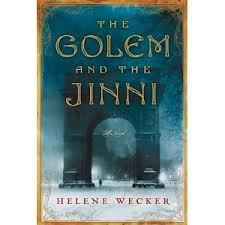 This book worked on so many different levels. It’s a great example of fantasy that transcends the genre, ultimately telling a story of immigrants in turn of the century New York who are struggling to fit in. It’s a book that moves at its own pace, winding through its characters’ day to day lives rather than a lot of drama or action. I was surprised by this slow pace but appreciated it, as you come to really know and like these characters.
This book worked on so many different levels. It’s a great example of fantasy that transcends the genre, ultimately telling a story of immigrants in turn of the century New York who are struggling to fit in. It’s a book that moves at its own pace, winding through its characters’ day to day lives rather than a lot of drama or action. I was surprised by this slow pace but appreciated it, as you come to really know and like these characters.
It’s amazing that this is her debut novel.
I read so many glowing reviews of this book, I didn’t think it could live up to expectations. It did. It does have some slow parts, but this is a book you shouldn’t put down.
The story begins with a lonely man in Poland who purchases a golem to be his wife. The golem is a monster of Jewish folklore, a person created out of clay with incredible strength and unswerving devotion to its master. As we learn in the first chapter of this book, the golem is particularly scary because this devotion will inevitably grow out of control. The golem can be destroyed by a single Hebrew word (unknown to most) but otherwise is invincible. The golem can read minds and pass as a human woman even under close contact.
The golem is taken on a ship bound for New York City, only her “husband” dies on the way over. So, days old, she begins her new life without a master. She befriends an elderly Jewish rabbi, who gives her a name and helps her to fit in.
The man was quiet as they walked. She realized she didn’t even know his name, but she hesitated to ask—he was lost in his thoughts. She could feel the questions circling in his mind, all with herself at their heart: what should I do with her? And in one brief flash, she saw an image of herself struck down, turned to a formless heap of dirt and clay in the middle of the street.
She halted, stock still. But instead of panic, she only felt a deep weariness. Perhaps it would be for the best. She had no place here, no purpose.
The jinni comes into this story when a metalworker in Little Syria fixes a lamp, and out he springs. The jinni is a fascinating character, because he formerly lived a life of great freedom and power, and he doesn’t know how he came to be imprisoned or how to free himself. He still doesn’t have most of his powers, and he’s also thousands of years out of his own time. The Jinni is all flash and fire, compared to the Golem’s cool clay.
You have to wait a while for them to meet, but this book never disappoints. Each of these creatures has a fascinating story in their own right, and it’s equally fascinating to experience these two different communities in New York City, living side by side but rarely touching. The Golem and the Jinni are outsiders, watching everything that happens around them, but never a part of their community. Wecker’s powerful narrative puts you right there.
Also fascinating is watching these two characters struggle to learn right and wrong, in a world that isn’t theirs. Neither of them asked to be there, but neither of them can avoid touching – and hurting – the people around them. The Jinni is seeking the answers to freeing himself, and the Golem is just trying to get by without destroying anyone and wondering what will become of her. She shouldn’t exist, but she does. Both characters struggle with whether to be themselves or hide their natures. Even a simple thing like a name takes on great importance when you don’t have one.
I loved how Wecker incorporated so many elements of folklore from two different cultures, while at the same time presenting a vivid portrait of the lives of turn of the century immigrants in Jewish and Syrian communities in New York City. At the same time, she’s created two characters you will sorely miss when this book ends.

